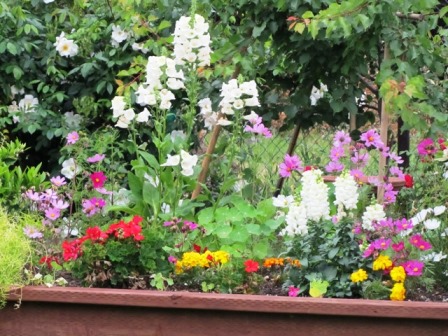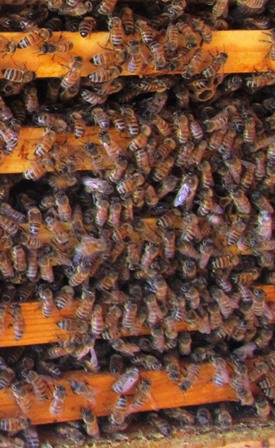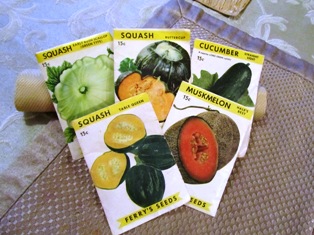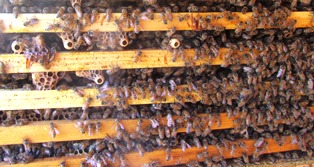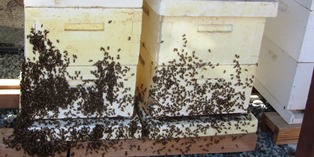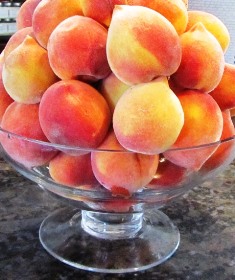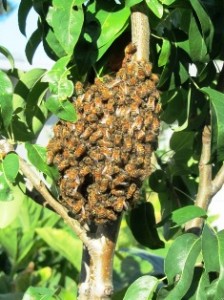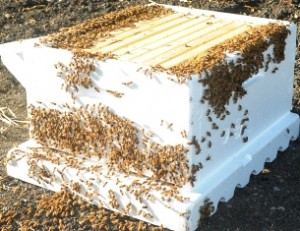Why Seed Saving Matters
Harvesting seed from my favorite flowers and vegetables has become of ritual for me. Basically, the plants do the work. I just pick the dried pods or seed heads, make sure they have an optimal period of time and the right environment to continue drying, and then store and/or share them.
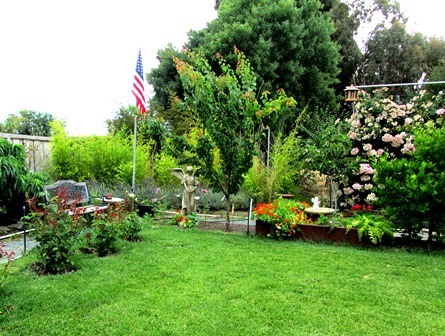
An heirloom rose, a raised box of open-pollinated vegetables or heirloom herbs, or a bed of flowers are easily integrated into this landscape to create a peaceful garden
With access to so many seed sources online and in local nurseries, some might wonder why I would bother collecting and saving seeds from plants I grow. The reasons are simple:
* Many open-pollinated heirloom varieties that I grow once were also grown in gardens generations before my time.
* It’s gratifying to know that through the plants we grow (without pesticides or altered through genetic manipulation), we can have pure and safe food that we grow ourselves.
* Crop diversity can only continue if gardeners and growers are saving seeds of diverse crop varieties.
* Harvesting seeds from what we grow completes the cycle of nature that takes place each year in our gardens.
According to Heirloom Gardener magazine, “Roughly 90 percent of the varieties that existed at the beginning of the 20th Century are extinct.” (Winter 2013-2014) That’s certainly a concern. We can’t bring back those varieties, but we can work together to try to stop further extinctions.
Passing on a garden is a great gift to the next generation. Passing on seeds is equally laudable. Saving seeds matters . . . for all of us who believe in preserving plant diversity.
Consumer Concerns Effect Change at Lowe’s and Home Depot
Increasingly, a growing body of science points to the role of bee-toxic pesticides (specifically neonicotinoids) in the global decline of the honeybee populations.
Lowe’s Home Improvement stores announced it will begin to phase out neonicotinoid pesticides (neonics are a class of pesticides harmful to bee health) as soon as suitable alternatives become available. The retailer will also provide customers with more educational materials focusing on pollinator health.
Home Depot has pledged to begin labeling plants on which neonicotinoids have been used. Other retailers are responding to consumer concerns as well.
East coast-based BJ’s Wholesale Club intends to require vendors to label plants free of neonicotinoids; otherwise vendors must label plants on which neonics have been used with a “caution around pollenators” tag.
Ten other retailers in states from California, Colorado, Minnesota, and Maryland have plans to limit or eliminate neonics.
A study published in the Journal Environmental Science and Pollination Research revealed that there is clear evidence that the use of neonicotinoid pesticides are a key factor in honeybee decline.
Backyard Gardeners and Farmers Have a Choice
We gardeners and farmers have a choice when putting in our gardens, fields, and orchards. We can choose open-pollinated, heirloom seeds, hybrids seeds, or GMO seeds. I much prefer the old-fashioned way of seed-saving and sharing of open-pollinated, heirloom varieties.
On our farmette, we routinely save seed from plants we grow in one season and use them during another. We have picked apricots from our backyard trees, saved the seeds, and grown new trees that (this year) bore fruit.
We’ve exchanged seeds with our neighbors who also keep organic gardens and prefer open-pollinated seeds. Seeds that are hybrid and/or GMO usually are patented, meaning scientific companies or growers own those patents.
Open-pollinated seeds do not carry patents and remain available to all of us to plant and replant.
Gathering seeds from the plants one grows is how our grandparents did it. I go around plucking seed heads from cosmos, purple cone flower, and the hardened seeds of nasturtiums when the flowers have faded. I’ve taken cuttings of all my roses and have been given clips from friends and neighbor’s bushes and now plenty of roses to line walkways and fill a garden.
This year, an apricot tree that we started two years ago after we ate the fruit and planted its seed, bore beautiful cots that I turned into jam. I’ve got a bountiful crop of onions (red and yellow) and garlic and peppers this year from last year’s seed. The cycle goes on.
The acronym GMO stands for “genetically modified organism.” The phrase means that scientists have used recombinant DNA technology to create the seed. In some cases, the purpose is to create seeds with pesticides spliced into their DNA to repel pests.
Some gardeners see this process by chemists, scientists, and researchers working of large petro-chemical companies as a dangerous venture into biological processes that have a long evolutionary history. Further, the concern encompasses the potential negative ramifications of genetically engineering a plant–what farmer wants to handle seed (much less eat the plant) that has warning labels about pesticides integrated into the seeds?
If gardeners stick with open-pollinated seeds and participate in seed saving and sharing, together we can ensure our Earth’s biodiversity continues. The other prospect is scary. Many species and cultivars of plants are no longer available. They are no longer being grown. Some have become extinct.
Scientific Studies Show Negative Effects of NeoNics
Neonicotinoids, commonly referred to as neonics, are a new class of pesticides that are closely related to nicotine. As the U.S. government debates the use of these controversial chemicals and studies go on, the European Union has voted to ban bee-harming pesticides. See, http://www.theguardian.com/environment/2013/apr/29/bee-harming-pesticides-banned-europe.
There’s no question that the bee population has been in decline in the last decade. Many beekeepers and experts alike have been vocal in their suspicions that exposure to neonicotinoid pesticides is a likely culprit. The journal Nature published a study that revealed significant negative effects on the wild bumble bee foraging on plants sprayed with the new class of pesticides.
Pollinators of all types are important to our food crops, but especially the bumble bees and honeybees. The latter are trucked around to farms and orchards (particularly the almond orchards) in early spring to pollinate the blossoms.
Exposure to neonicotinoid pesticides resulted in wild bees doing less reproducing, having smaller colonies, and having colonies that didn’t grow as compared to wild bees not exposed to the neonics.
One of the studies was the result of research done in the wild, using 16 patches of land divided into two parcels of eight patches each. One area used canola seeds coated with the pesticide containing neonics. The seeds were not coated in the other area.
Scientists then compared the bees exposed to the pesticide with bees not exposed. The treated side had half as many bees per square meter as the untreated side. The bees in the pesticide patches also had negligible weight gain, but the bees in the untreated area gained roughly one pound.
Neonicotinoids are now the world’s most widely used pesticides. Isn’t it time farmers of the world found other options and chemical companies put less money into lobbying for these bee-dangerous chemicals and instead searched for good alternatives to help farmers deal with pests in their fields and orchards?
Puzzling through a Cozy, Weeping at a Memoir, and Forgetting the Peach Pie
I couldn’t breathe in yesterday’s heat. But with so much work to be done around the farmette, I soldiered on, staking heirloom blue tomatoes. I hadn’t finished canning my organic apricots and now the plums and peaches were ready. I felt overwhelmed and longing for cool spot to sip tea, rest, and read.
We had already removed the apricots from our “torture tree” since we’ve been unable to surmount its many problems after planting it five years ago. Carlos wasted little time chain-sawing it down. I deadheaded the roses, while he dug out the stump.
Then with a clear view to our hives, we quickly realized that the we needed to suit up and install extenders or the bees would swarm. Even as we felt the urgency, we realized there were also dozens of other chores screaming for our attention.
I told myself that breezes would soon blow inland from the Carquinez Strait, a channel of the San Francisco Bay where the San Joaquin and the Sacramento Rivers flow to the ocean, but by mid-afternoon, nary a leaf moved on the apricot, plum, and pomegranate trees. By four o’clock when the wind finally did kick in–the air wasn’t cool as it usually was. The winds blew strong and stifling hot and threatened to suffocate anyone still working outside.
Abandoning the outside chores, I retreated indoors and turned on the air conditioner. Seeing the lug of apricots and crock of peaches resting on the kitchen counter, I groaned. The jam had to be made, but I couldn’t face stirring boiling fruit on a hot stove.
Deciding to use up some of the fruit for a simple after-dinner dessert, I flipped through the pages of a few cookbooks. Maybe a cobbler would do or a peach pie. I really didn’t need a recipe for those, but in Country Cooking by Dori Sanders, I found an intriguing raisin-cinnamon crust that sounded tasty. I bet it would go with peaches but I probably could have baked it on the patio floor.
With a glass of sweet tea and an armload of paperbacks and hardcovers, I curled up on the couch and finished reading Murder is Binding, Lorna Barrett’s debut book in her cozy Booktown Mystery series. I love this author and her writing, but soon figured out who done it. Still, I read to the end; you never know when a clever twist might show up.
Next, I read the last few pages of A Tuscan Childhood by Kinta Beevor. At bedtime, I’d been savoring the chapters of that book like pieces of rich, dark chocolate. Beevor’s evocative descriptions of her bohemian childhood in Tuscany captured my imagination, drawing me in so completely I could almost smell the wild thyme, pine needles, and rocky Tuscan terrain in the searing, summer heat. Like Frances Mayes (Under the Tuscan Sun), who wrote a quote for the cover, I felt sad when Beevor’s lovely memoir ended.
Returning to the stack, I selected another memoir, The Orchard, by Theresa Weir. I’d bought the book on impulse during a trip to the farmers’ market at Todos Santos Plaza, our downtown green space surrounded by bars and banks and, of course, a second-hand bookstore. Drastically marked down, the book had been summarily deposited on a set of moveable shelves, and rolled outside the storefront for a quick sale.
The artist and writer in me understood immediately why I had picked it up and purchased it: the cover art pictured a young couple in a loving embrace, standing in lush green grass surrounded by apple trees. But there was something in that image that evoked sadness, like a bittersweet dream of a time past, viewed through a long lens.
As the descendant of five generations of farmers, I suspected Weir’s book would resonate with my own experiences of farm life in America’s heartland with bone-chilling winters of snow and ice and sweltering summers when you prayed for rain. What I didn’t expect was exquisite writing and the juxtaposition of love against the deadly realities of widespread pesticide use on the farms that ushered me into her story and swept me along. I finished that book in one sitting and will long be haunted by it.
I felt guilty for having only paid pennies for Weir’s book. A pittance for a tale that evolved out of all she had lived through. Less than the price of bus fare to journey with her as she pieced together scenes from her life in the Heartland. In every page, I was with her as she struggled, never abandoning her dreams. She learned as I had how to tuck them away while you dealt with the realities of a hard life with heart-breaking lows and highs that reached euphoria. But there were scenes she left out, only hinting at experiences she said she would “never talk about.” The truth is, I wept after putting down her book.
When a reader identifies so closely with a character in a story (and this was Weir’s personal narrative of her life), he or she rides the emotional ups and downs with that character. Good writers understand how to tug at their readers’ emotions and milk the drama. Theresa Weir had skillfully threaded a leitmotif of darkness and light, joy and sorrow, pain and healing through her story, but never once did I feel manipulated. Every sentence of The Orchard rang true.
I couldn’t read anymore after putting that book down. As I made dinner, I thought of how many scenes in her life resonated with mine. Even the widespread pesticide use on farms and the stubbornness of farmers to change.
I thought about Rachel Carson’s famous book, Silent Spring, that sounded the wake-up call to farmers everywhere about the dangers of chemicals in fertilizers, pesticides, and herbicides. So many small farms have been overtaken by agribusinesses these days and still the chemicals are used. I decided to forgo making the peach pie.
With the heat of the day gone, I opened the windows and stretched out between freshly washed sheets. I listened to the rustle of oak and eucalyptus leaves. To crickets and the unseen critters that make noises in the night. I listened to the soft voices of my Lebanese neighbors chatting in their orchard with relatives.
As dreams beckoned, I could almost smell the fresh lilacs that Theresa Weir had written about in her memoir. Their cloying scent had filled her grandmother’s kitchen just as they had filled my grandmother’s, my mother’s, and mine. I wondered if the lilacs would ever disappear or if the world would one day wake up to find the honeybees gone, the fruit trees without fruit, and the berries and other sweet produce in our gardens and orchards reduced to a memory.
Protecting Honeybee Hives
In early October, I helped my beekeeper neighbor medicate his honeybees as well as the bees in the hives he had given me. Our work will ensure the bees make it through the winter. Although some beekeepers do not believe much in the value of medicating bees to ensure the health of the colony, my neighbor (who learned beekeeping at the knee of his father) maintains a healthy colony of bees that are flourishing and producing large quantities of honey.
Healthy bees are necessary for pollination of our nation’s crops. For reasons not well understood, roughly one-third of all the U.S. honeybee colonies have disappeared since 2006 when beekeepers in America and Europe sounded the alarm that worker bees were not returning to their hives and disappearing at alarming rates. Initially beekeepers and scientists postulated that the honeybee problem could be traced to infection by mites, a fungus, a weakened immune system, contact with pesticides, and/or stress or combinations of several factors. More recently, studies are suggesting that the CCD problem possibly is related to the use of neonicotinoids, a new class of pesticides introduced in the 1990s.
Chemically linked to nicotine, neonicotinoids are associated with diminishing bee populations in several new studies, although the Agriculture Research Service (ARS), the internal research agency of the U.S. Department of Agriculture, asserts that little is known about the causes of CCD. The ARS offers the following advice to beekeepers: “mitigation must be based on improving general honey bee health and habitat and countering known mortality factors by using best management practices. This includes supplemental feeding in times of nectar/pollen scarcity.” See, http://www.ars.usda.gov/News/docs.htm?docid=15572#bk
Commercial beekeepers feed their bees corn syrup and neonicotinoids have been used routinely on corn. Recently, Harvard Professor Chensheng Lu was quoted in a New Yorker article as stating he believes one reason for CCD is the “link between high-fructose corn syrup and use of neonicotinoids.”
So while my neighbor and I can medicate against pathogens and parasites, we will be watching to see what the EPA, the USDA, and other governmental agencies decide about the widespread use of pesticides and specifically the use of neonicotinoids.
 Facebook
Facebook Goodreads
Goodreads LinkedIn
LinkedIn Meera Lester
Meera Lester Twitter
Twitter






